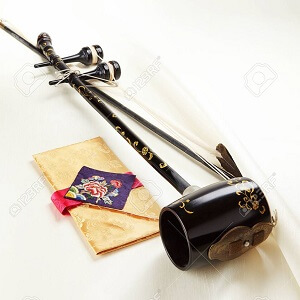Haegeum
 Haegeum is a traditional string instrument in Korea that resembles a fiddle. It has a rodlike neck, a hollow wooden sound-box, and two silk strings, and is held vertically on the knee of the performer and played with a horsetail bow. I have seen the haegeum since I have watched a Korean drama, Dong Yi. When I listen to the sound of the haegeum, I was totally attracted by the silky sad sound. I replayed the same scene over and over. Dong-Yi was born from a poor family in a lowest cast in Choseon Dynasty. Her father died because he rebelled against Choseon aristocracy. She was an orphan. As one from the lowest class she became the Queen of Sookjong (1661-1720). Her son (Youngjo, 1694-1776) became one of the most powerful kings in Choseon Dynasty (1392-1910). When she experienced suffering she comforted herself by playing haegeum. The King was attracted by her play and fell in love with her. The sound of haegeum connected Dong-Yi and the King.
Haegeum is a traditional string instrument in Korea that resembles a fiddle. It has a rodlike neck, a hollow wooden sound-box, and two silk strings, and is held vertically on the knee of the performer and played with a horsetail bow. I have seen the haegeum since I have watched a Korean drama, Dong Yi. When I listen to the sound of the haegeum, I was totally attracted by the silky sad sound. I replayed the same scene over and over. Dong-Yi was born from a poor family in a lowest cast in Choseon Dynasty. Her father died because he rebelled against Choseon aristocracy. She was an orphan. As one from the lowest class she became the Queen of Sookjong (1661-1720). Her son (Youngjo, 1694-1776) became one of the most powerful kings in Choseon Dynasty (1392-1910). When she experienced suffering she comforted herself by playing haegeum. The King was attracted by her play and fell in love with her. The sound of haegeum connected Dong-Yi and the King.
The haegeum is an ancient Korean instrument known for its pathos and vocality. Dating from the Koryeo Dynasty (918-1392), the instrument is a small, two-stringed fiddle with a slender, rod-like neck and round sound box. Traditionally fashioned of gold, rock, thread, bamboo, gourd, soil, leather, and wood, haegeum possesses paleum or “eight sounds”; it is gifted with a colorful tonal palette and broad expressive range. In the context of a traditional Korean orchestra, haegeum is considered a wind instrument because of its ability to sustain haunting melodies. The bow is permanently looped between the strings, a unique design that likely stems from a time when it traveled with people on horseback; the haegeum, after all, was of no use if you lost the bow in transit. To perform, a musician typically sits in a half-lotus position with the right leg wrapped over the left knee and the sound box resting on top. The face of the instrument is turned inward and perpendicular to the player’s body, making it possible to transition the bow smoothly between the thicker inner string and thinner outer string (tuned a perfect fifth apart).